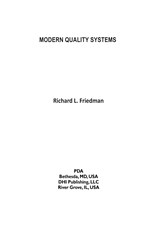Modern Quality Systems (single user digital version)
- Format
- PDF Single user
- Member Price
- $75.00
- Nonmember Price
- $89.00
- Government Price
- $35.00
Please sign in or become a member to purchase items from the PDA bookstore.
This chapter is taken from the book Microbiology in Pharmaceutical Manufacturing, Second Edition, Revised and Expanded, Volume 2
No industry's products more intuitively illustrate the importance of product quality than those produced by pharmaceutical manufacturers.
Quality managers are especially effective when a commitment to continual improvement is shared throughout the organization. The recent noteworthy
movement toward industrial modernization has included a realization that
opportunities for updating manufacturing and laboratory technologies are
abundant, and a strong Quality System will provide the accompanying
infrastructure in which to drive this emerging renaissance. This modernization
trend intertwines with the Quality System by emphasizing an improved product
development paradigm; technological advances in production, monitoring and
control; and systematic methods for managing risk.
This chapter addresses the "top twenty" features of a well-managed Quality System, from this author's CGMP perspective. Each of the features is integral to an effective Quality System, and the presence or absence of any one can be revealing with respect to an organization's quality philosophy and culture. Some concepts discussed, including needed improvements in microbiology laboratory methods development and analyst qualification, will benefit from further articulation by industry and regulatory agencies in the coming years.
Available to download. Prior to purchase please view the download instructions and Terms of Usage.
Format: Digital PDF (1 file - 358 KB)
Table of Contents
Table of Contents:
- Global Quality Assurance
- Quality Foundation
- Good Science
- Intended Use
- People: Qualifications, Roles, Responsibilities
- Reliable Laboratory
- Suitability of Equipment, Facilities, and Associated Procedures
- Raw Material Quality and Surveillance
- Batch Review and Release
- Documentation
- Effective Development and Process Validation
- "Building Quality In" and the Willingness to Fix a Flawed Process
- Effective Use of Risk Assessment
- Understanding Sources of Variability and Signals of Drift
- Awareness of the Link Between Safety, Efficacy, and Quality
- The Quality Organization: Authority, Responsibility, and Accountability
- Taking Action When Necessary
- Internal Audit Program
- Contracting and Outsourcing Scrutiny
- Modernization: Knowing the Current Science and Employing Contemporary Technology
About the Authors
About the Authors
Richard L.
Friedman is the Director of the Division of Manufacturing & Product
Quality in the Center for Drug Evaluation and Research (CDER). In this position,
he directs the interpretation and development of CGMP policy, review of
inspectional recommendations, and determination of manufacturing site
acceptability. He has been employed by FDA since 1990, including prior positions
as New Jersey District Drug Specialist, CDER Senior Compliance Officer, and Team
Leader of Guidance and Policy. Mr. Friedman has authored several publications on
topics including sterile drugs and quality management systems, and was awarded
The George M. Sykes Award by the Parenteral Society for outstanding journal
paper for the year 2005. Mr. Friedman is also an adjunct faculty member of
Temple University School of Pharmacy in their QA/RA graduate program. Prior to
joining FDA, Mr. Friedman worked in the toxicology research division of an
innovator pharmaceutical company. Mr. Friedman received his B.S. in Biology with
honors from Montclair State University in 1989 and his M.S. in Microbiology from
Georgetown University School of Medicine in May, 2001.

